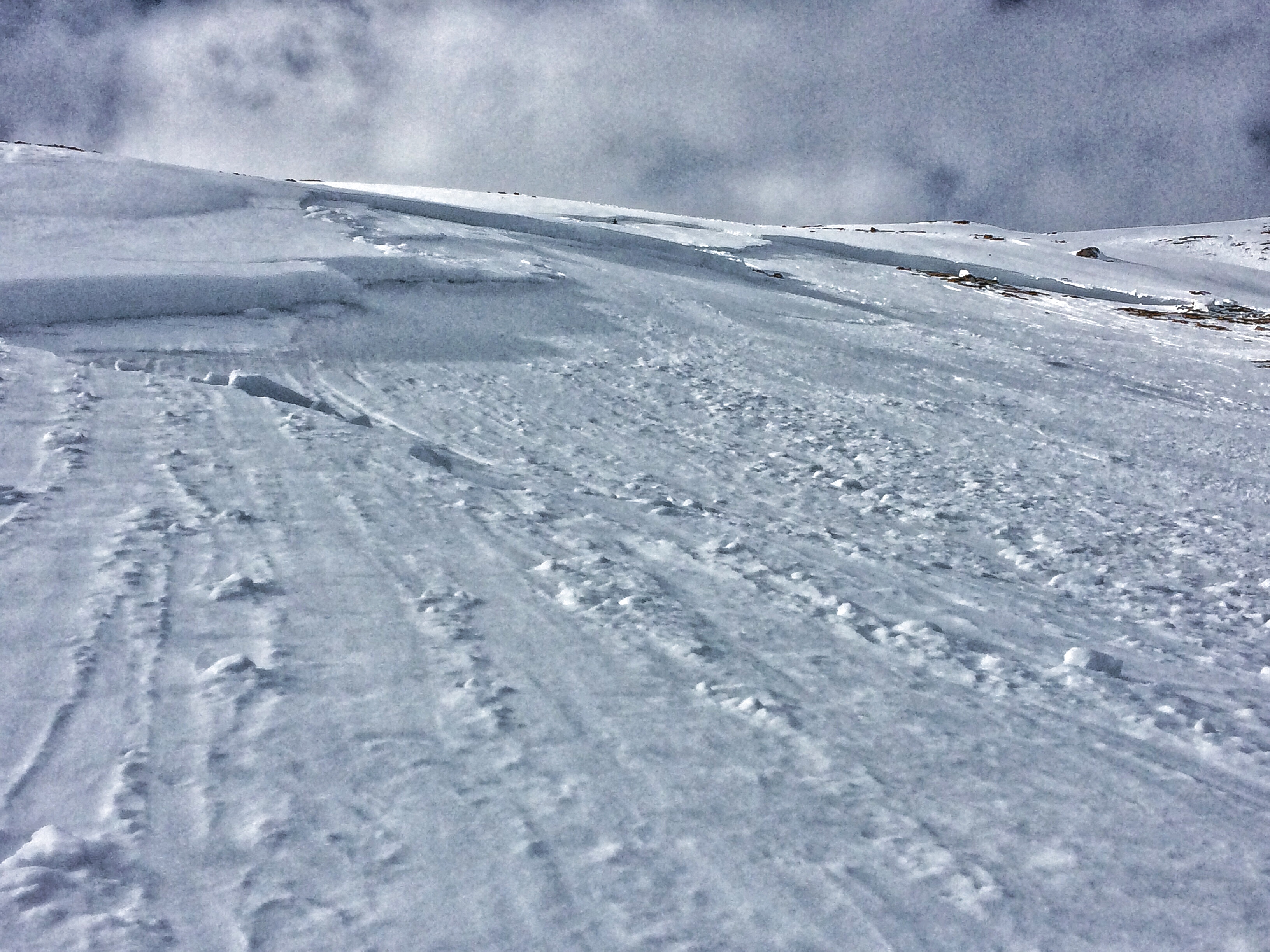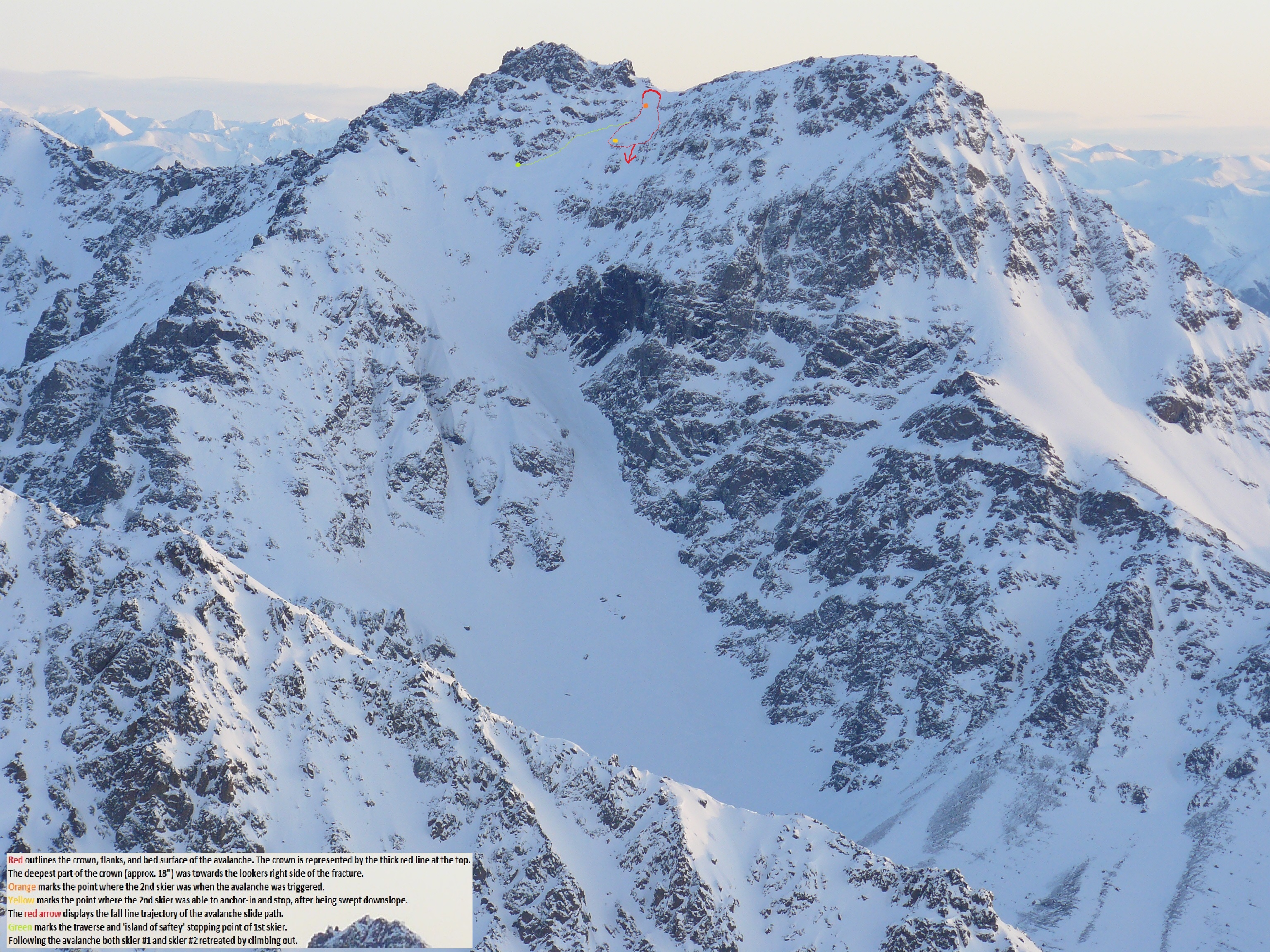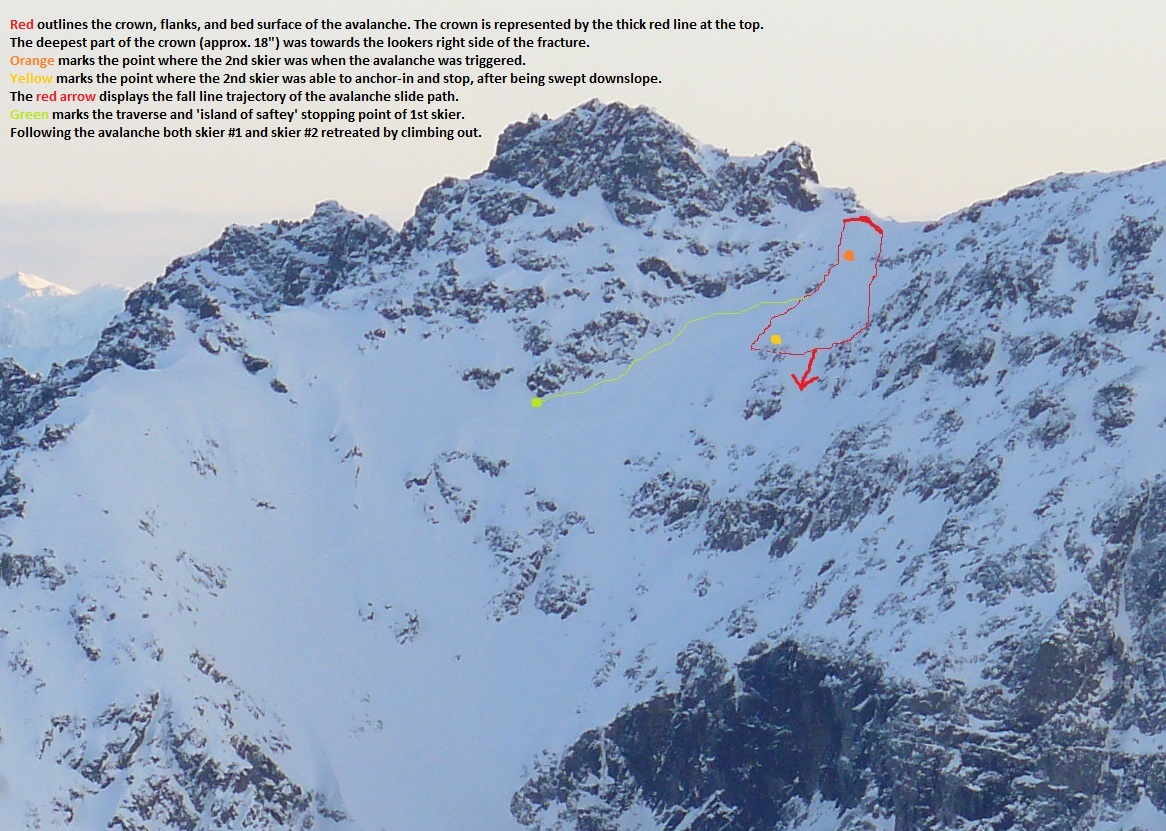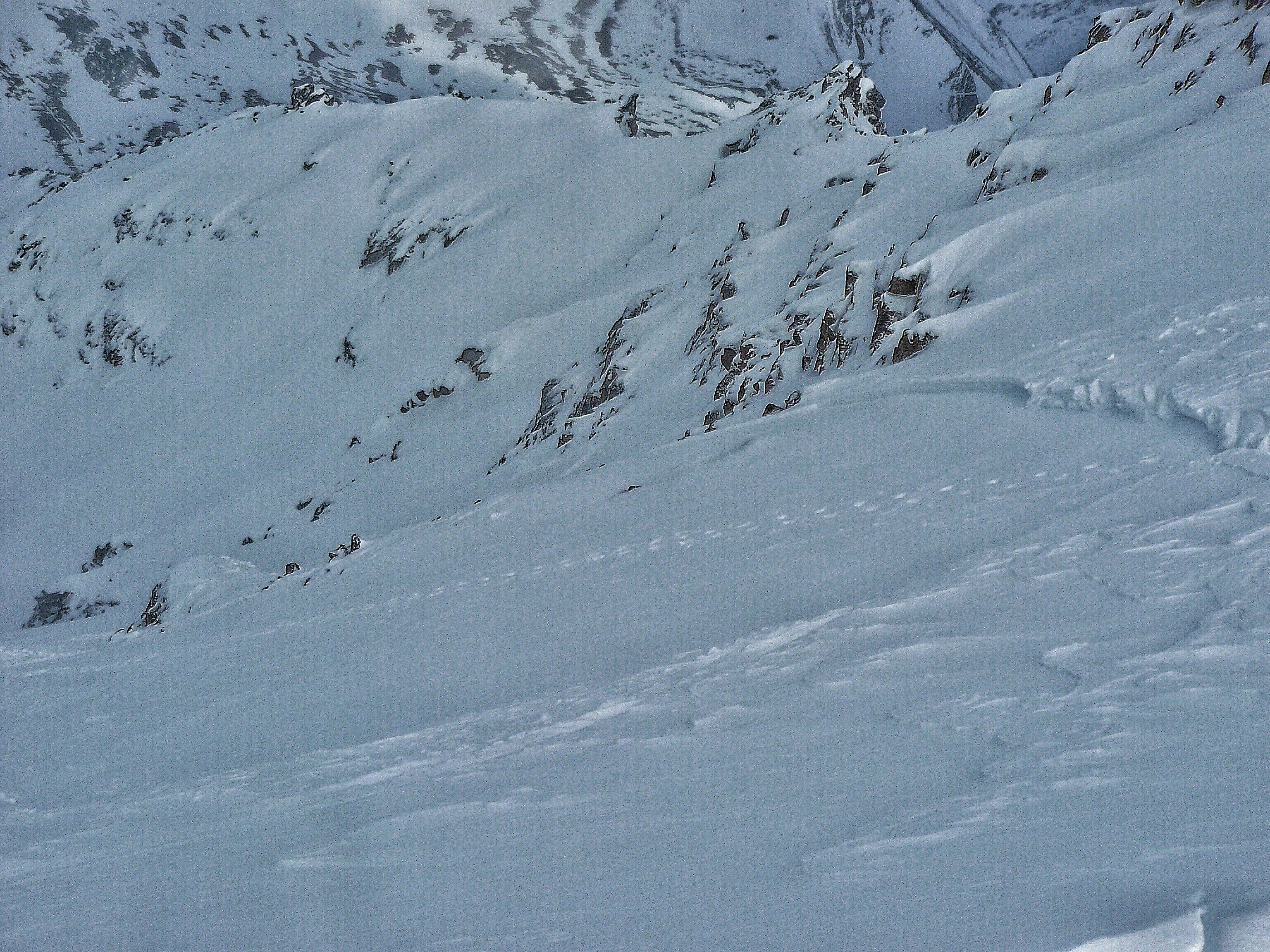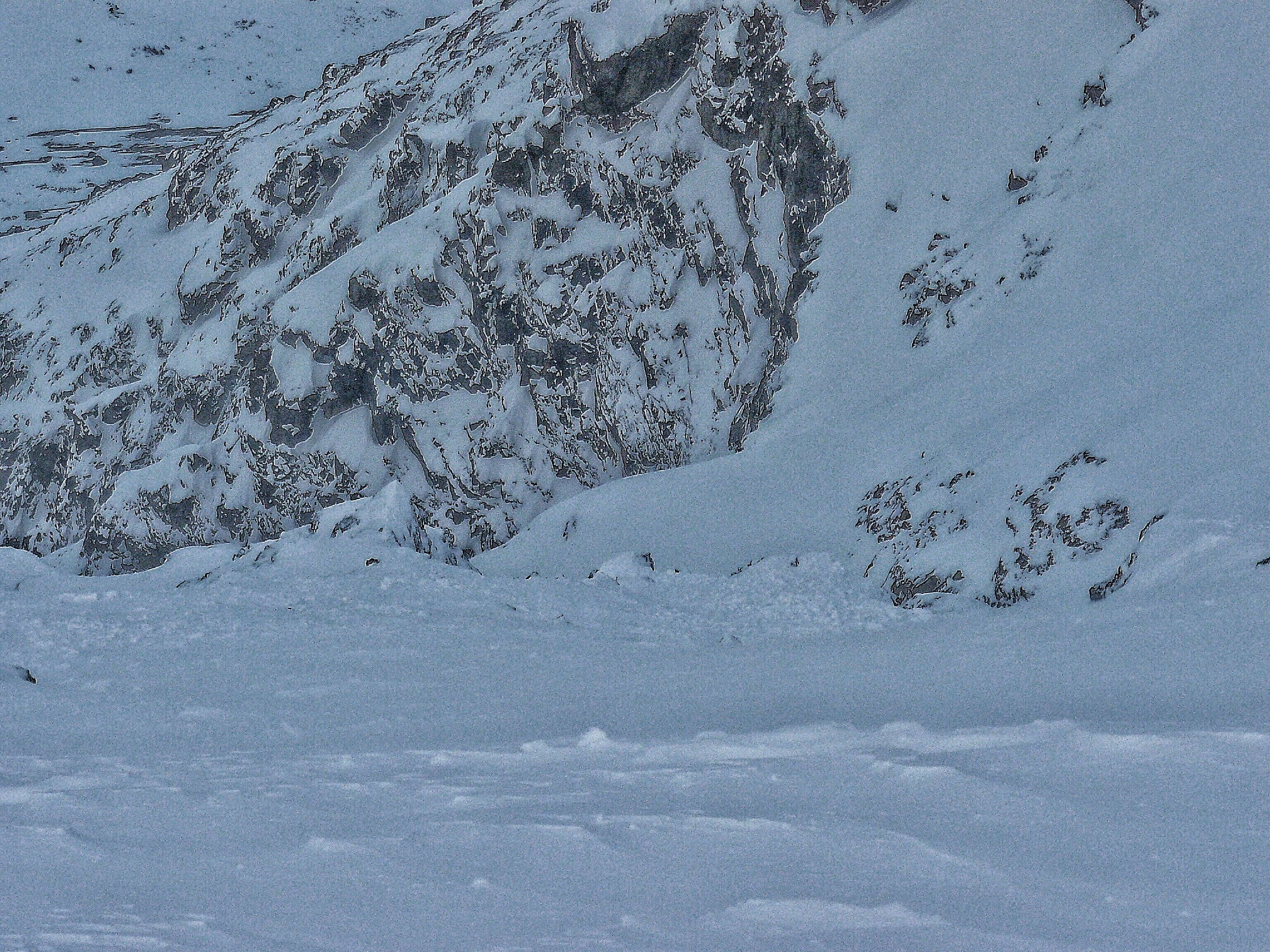Observations
South Fork Eagle River: Hunter Pass, North Bowl, The Nipple
Red flags (obvious signs of instability):
- Several recent natural and human triggered avalanches
- Warm temperatures and intense solar radiation
- Wet, gloppy, and unsupportable snow (isothermal in many areas below 3000′ where the snowpack is shallower)
Weather:
- Alpine temps well above freezing by 10am with only a superficial freeze from the night before in more shaded areas
- Mostly cloudy, but plenty of sun, with quickly passing and very light snow showers
- Light SE wind
Surface conditions:
- Below 3000′: a few inches of wet surface snow becoming moist for several inches more below, to either the ground or old wind-packed snow. Superficial, unsupportable melt-freeze crust in shaded areas.
- Above 3000′: several inches of moist surface snow with ground or old, windpacked snow below. Denser, wind-affected snow in exposed areas (mainly near ridgeline and cross-loaded gullies).
Snowpack:
~3′ of wind loaded snow along the the lee side North Bowl ridge N-NW aspect: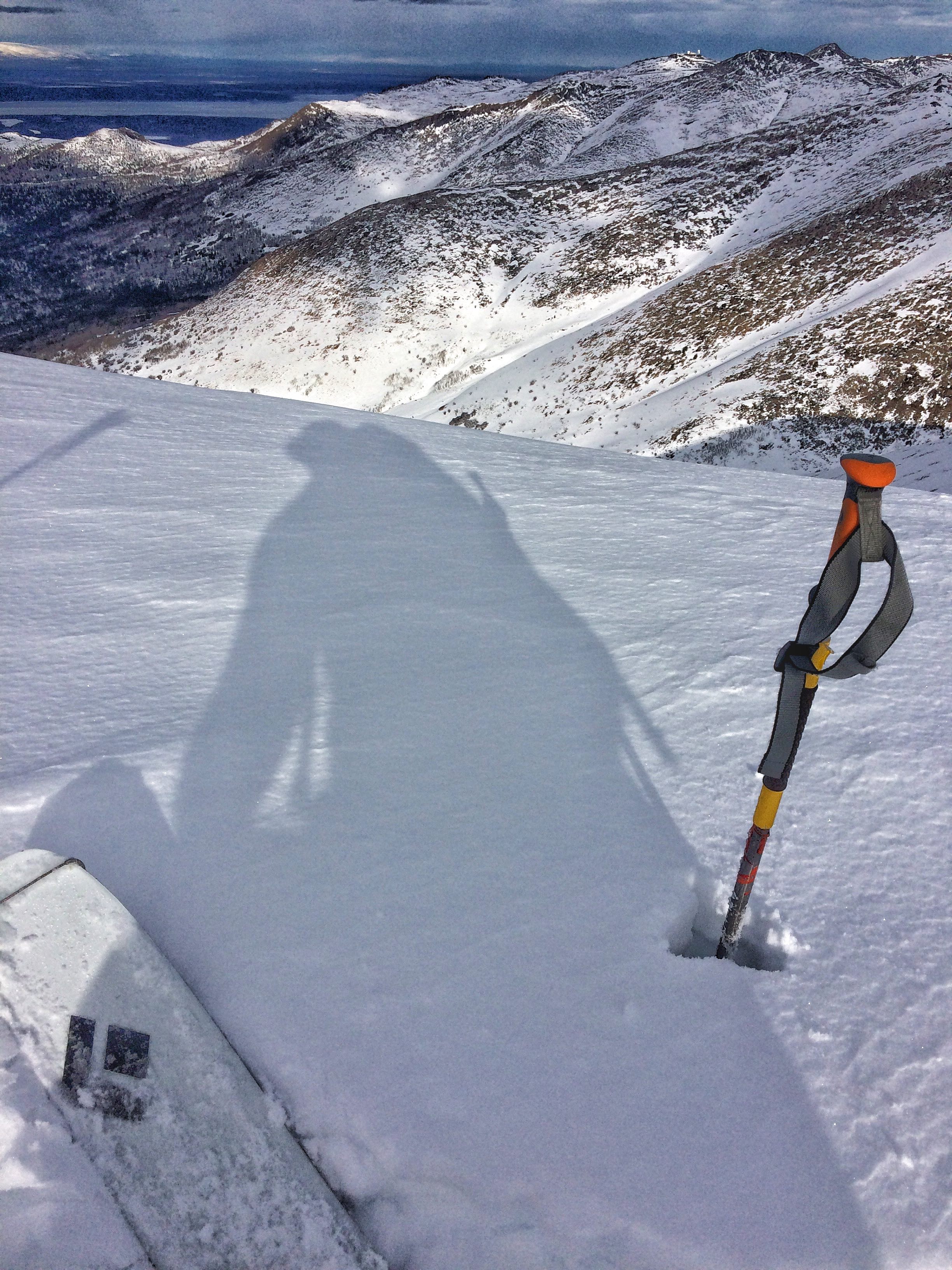
North Bowl cornice drooping (possibly open cracks under wind blown snow, but didn’t approach):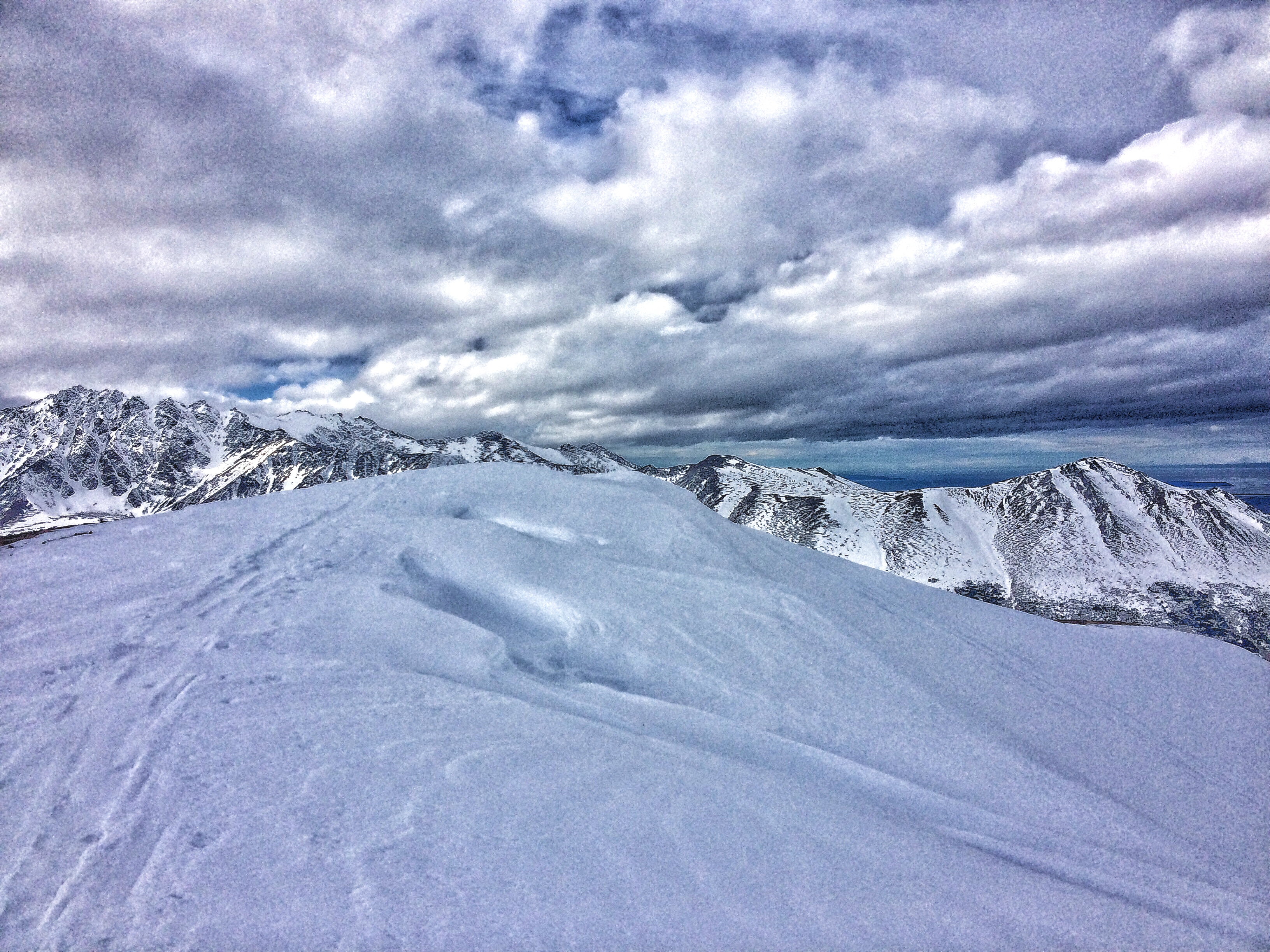
Better views (from Hiland Rd) of Sunday’s (3/20 observations here) human triggered avalanche (SS-ASu-R2-D2-O) that caught and carried three people (ran ~630′ from 3156-2524′, crown 100’+ wide and 3’+ deep)…(note human triggered wet loose from ridge line – likely from Sunday evening or Monday):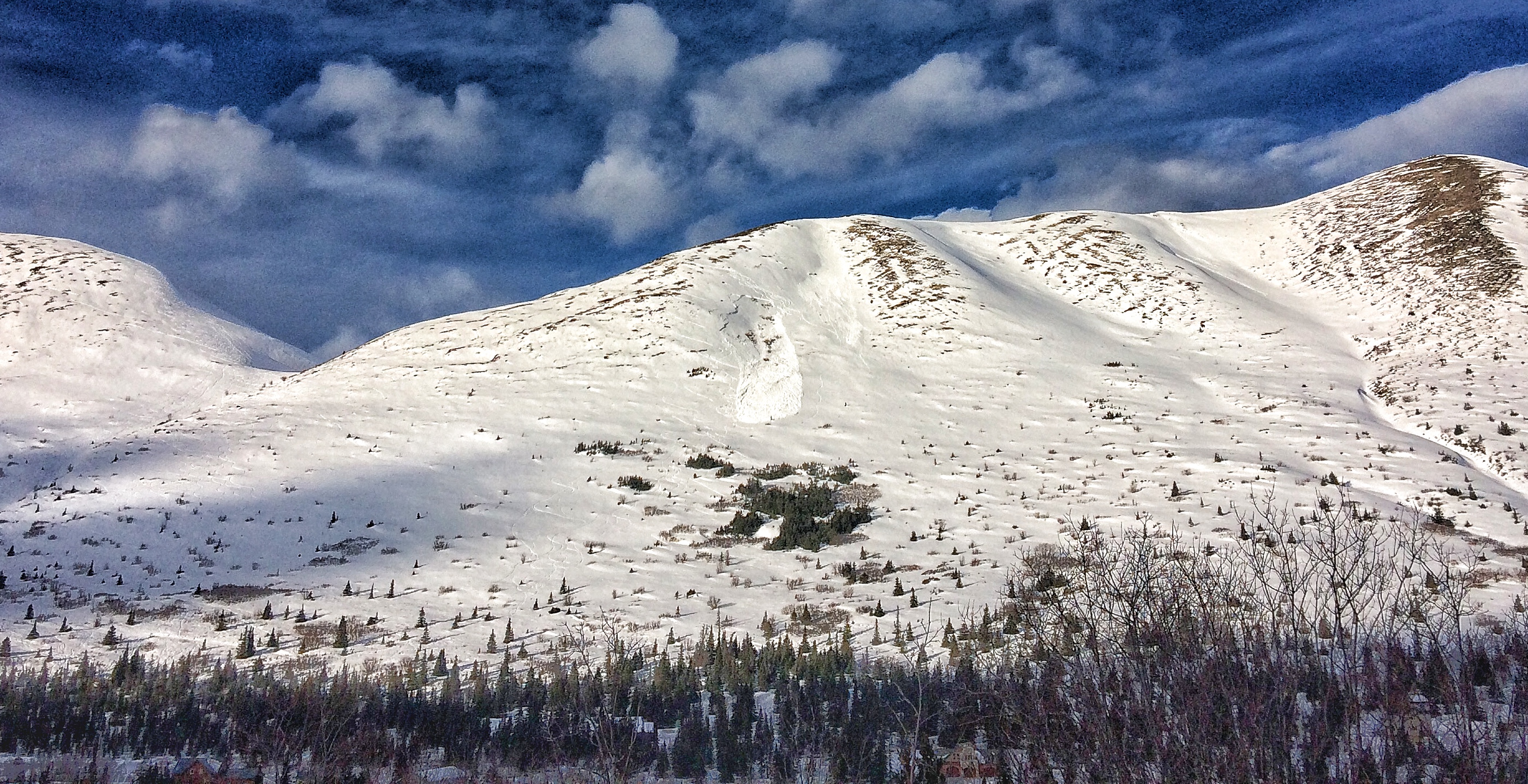
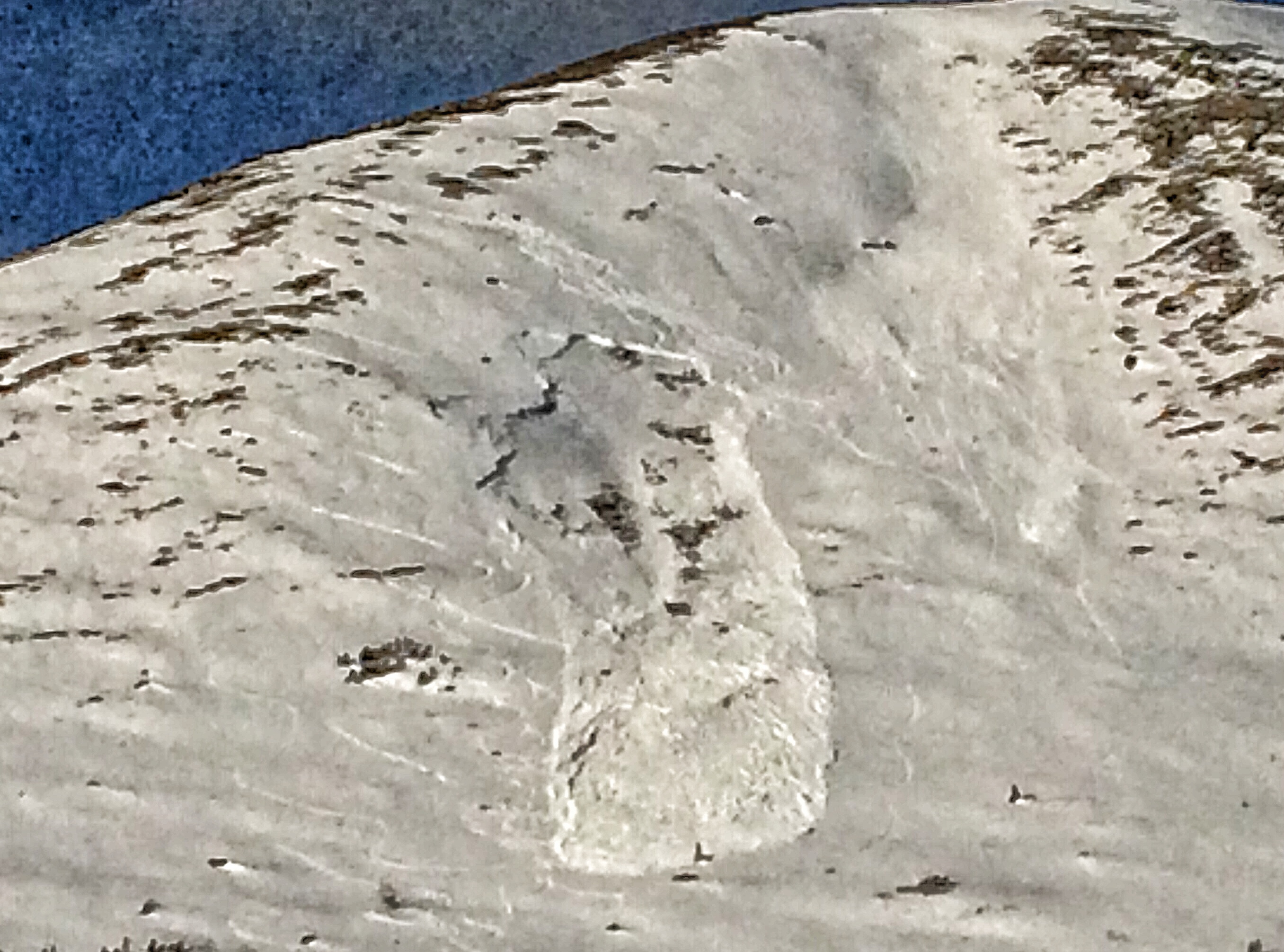
View from the trailhead parking lot: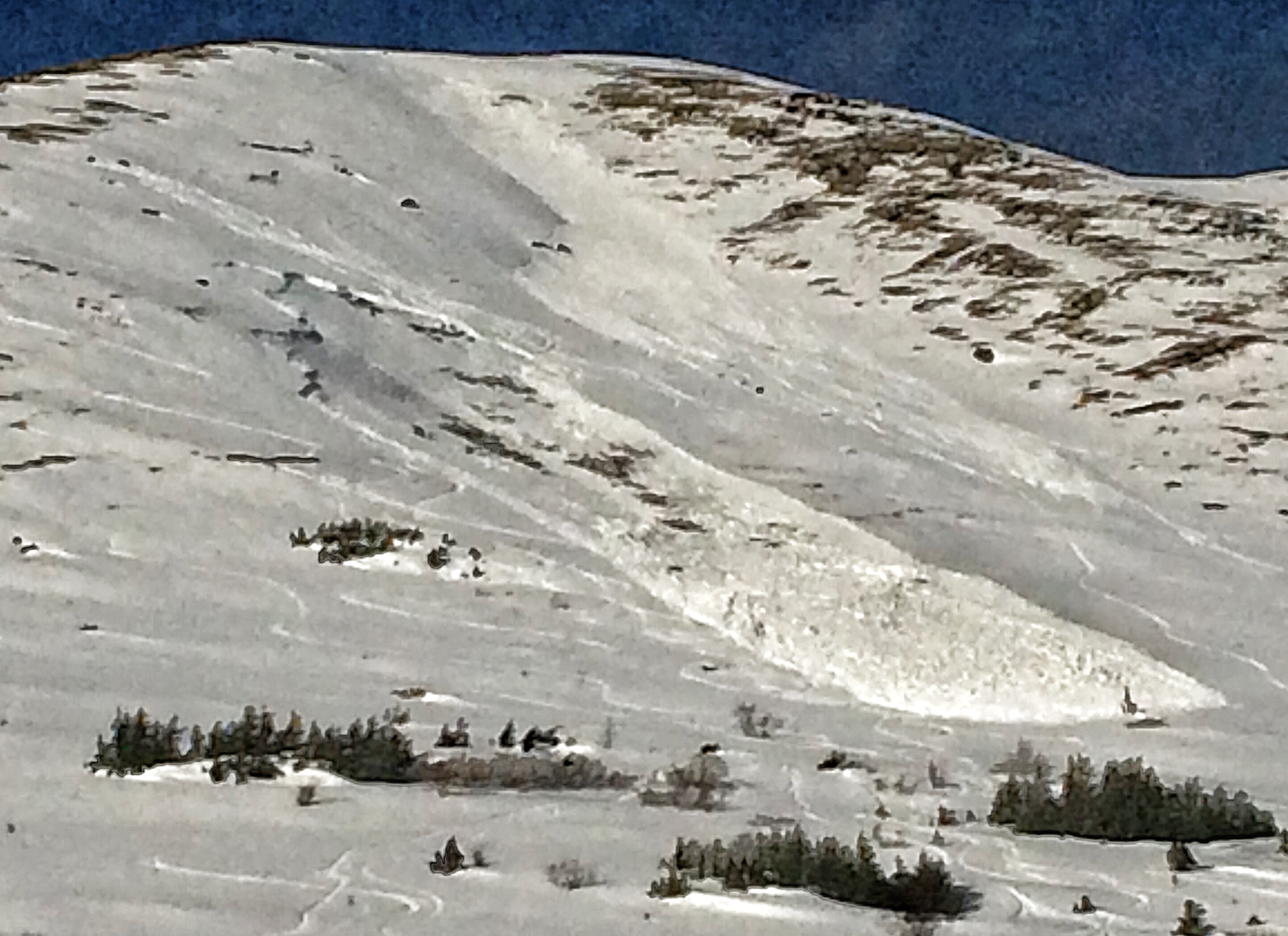
Views of the crown from the skier’s left flank: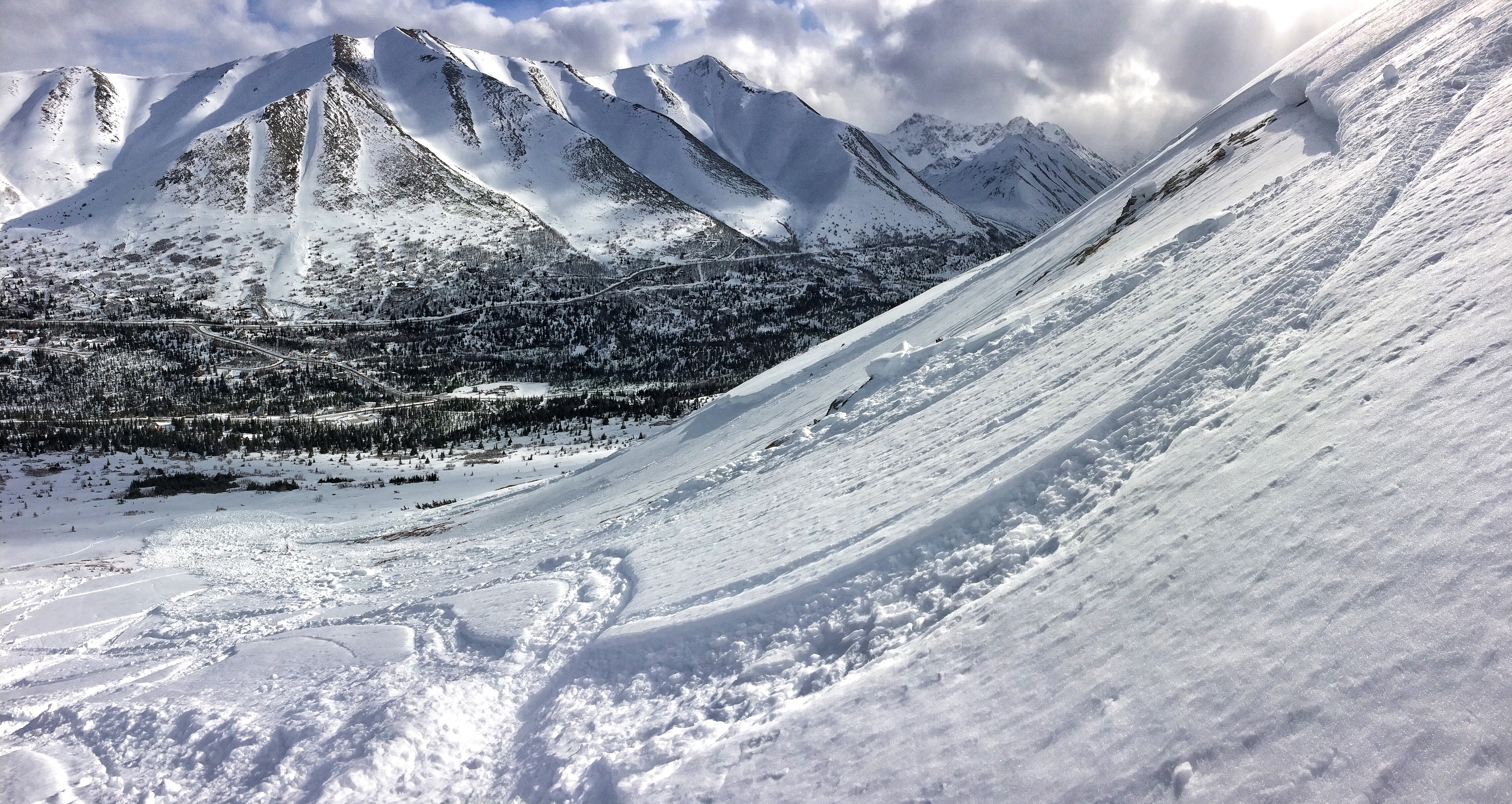
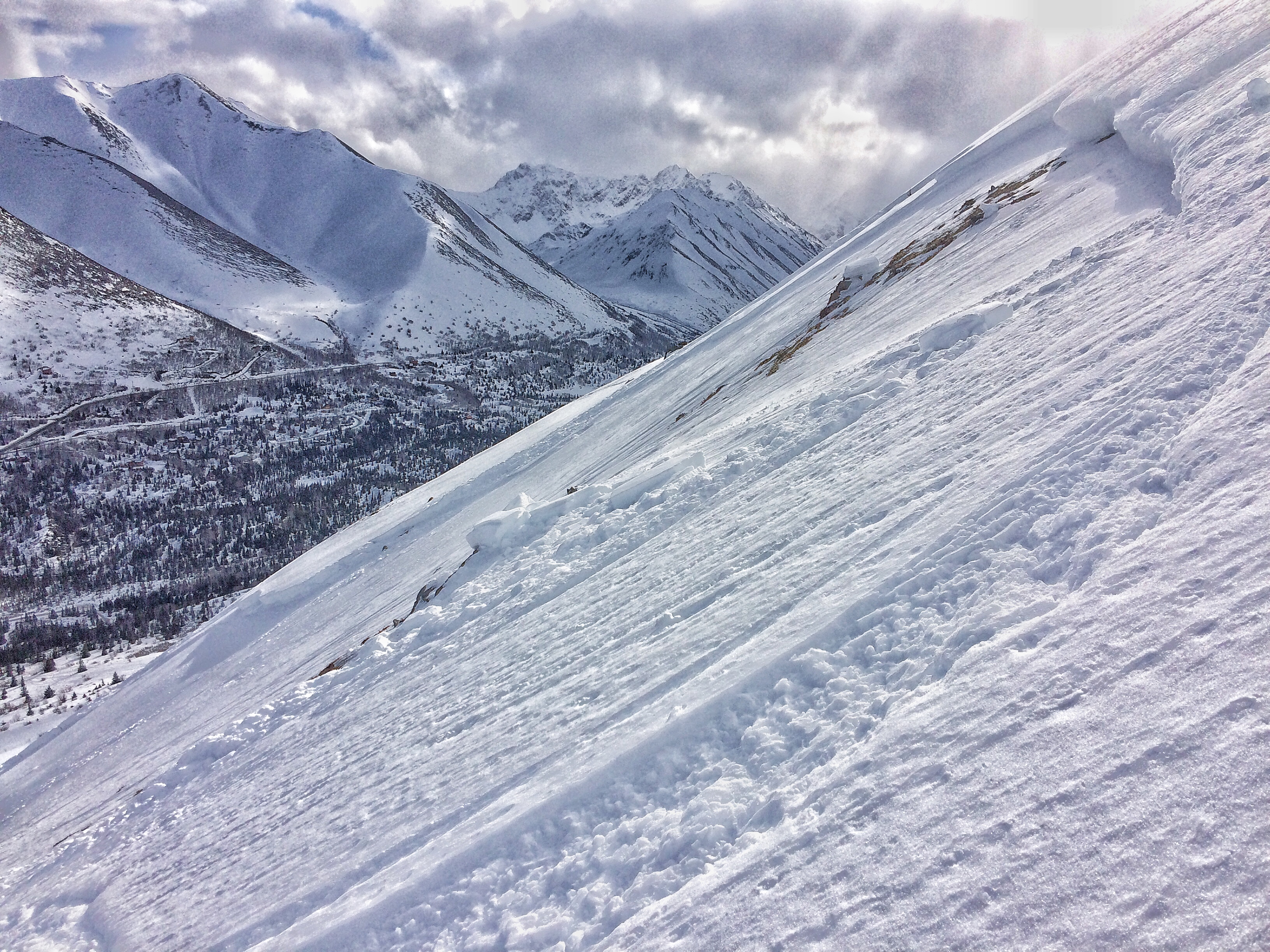
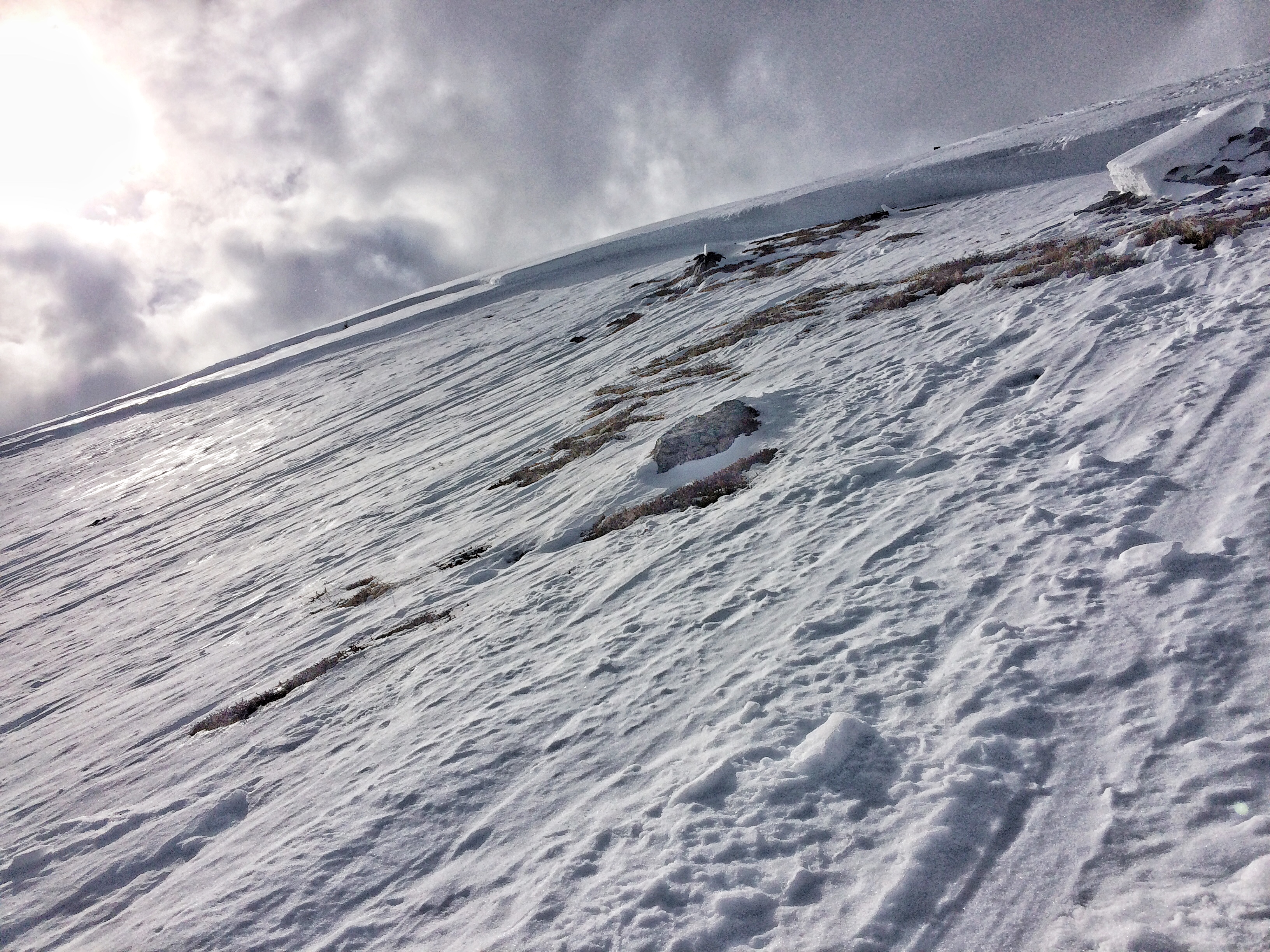
130cm pole with crown for perspective (note multiple fracture planes):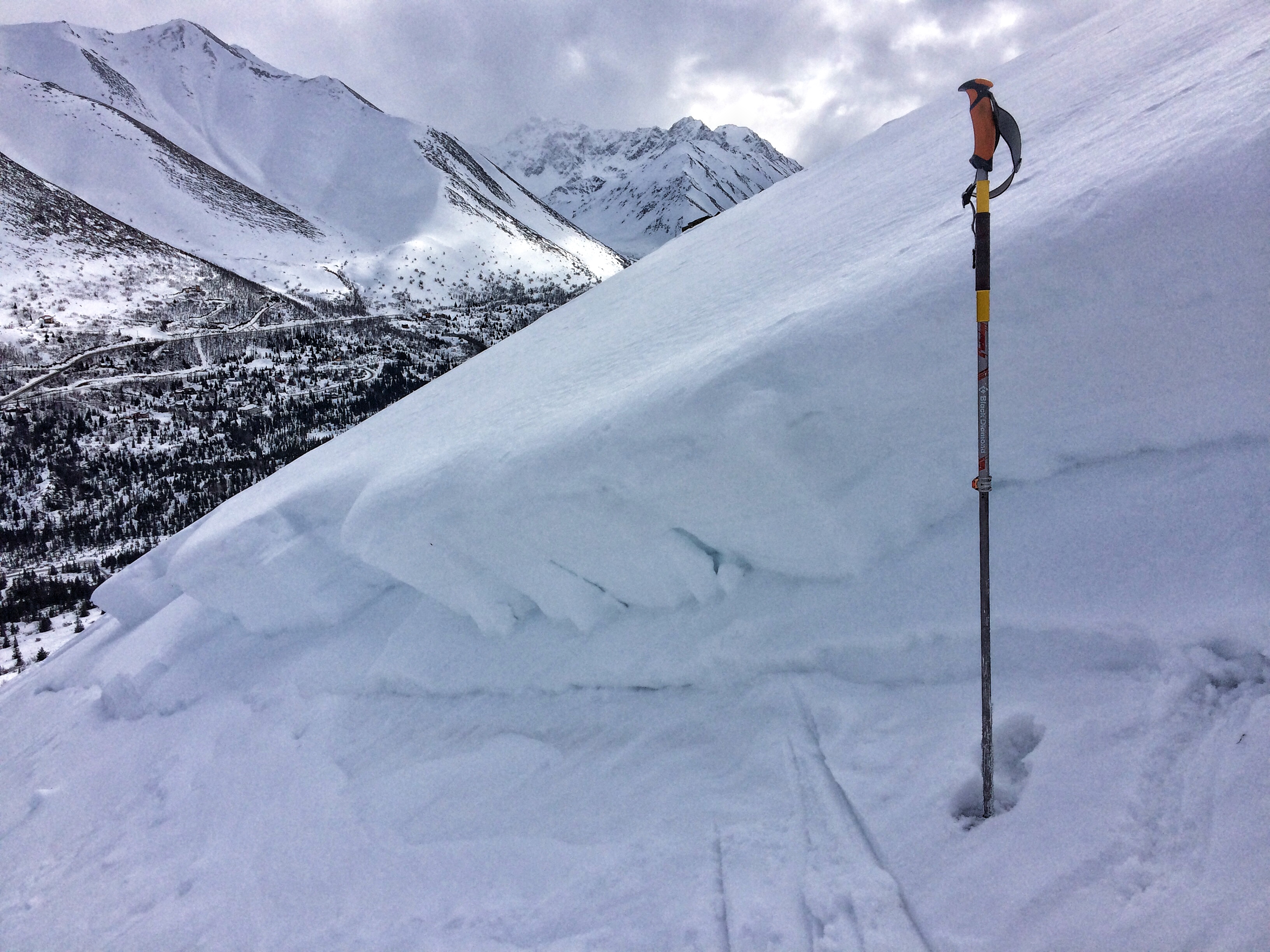
The avalanche appeared to have three fracture planes 1. where the skier initiated the slide from a steep rollover on a persistent weak layer near the ground 2. as the fracture propagated to the skier’s right a fracture initiated at the interface with looser, drier snow from Wednesday-Thursday and 3. at the interface of Wednesday-Thursday snow with old, hard wind-packed snow (assessment was limited today due to exposure to hangfire and very warm weather):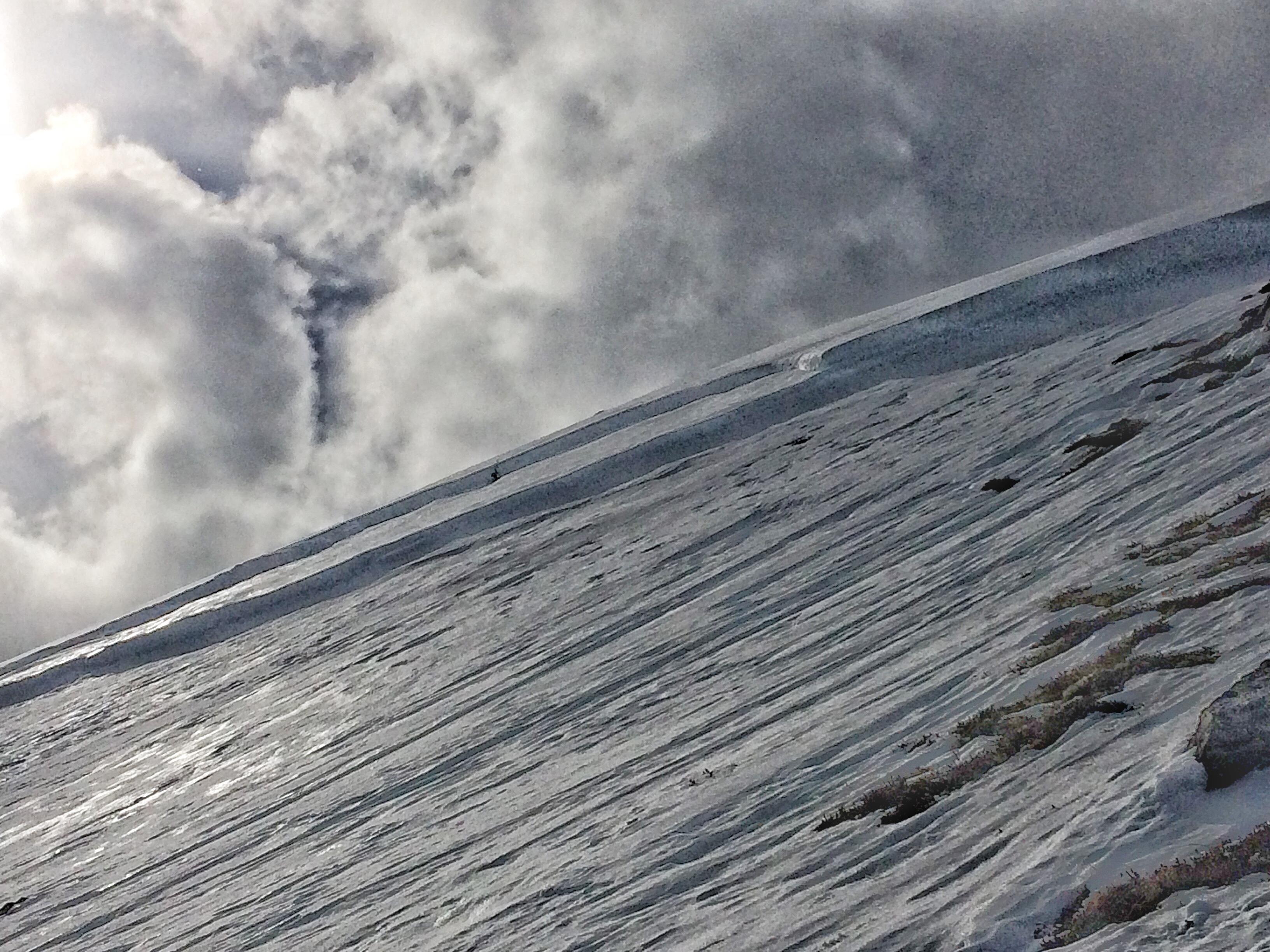
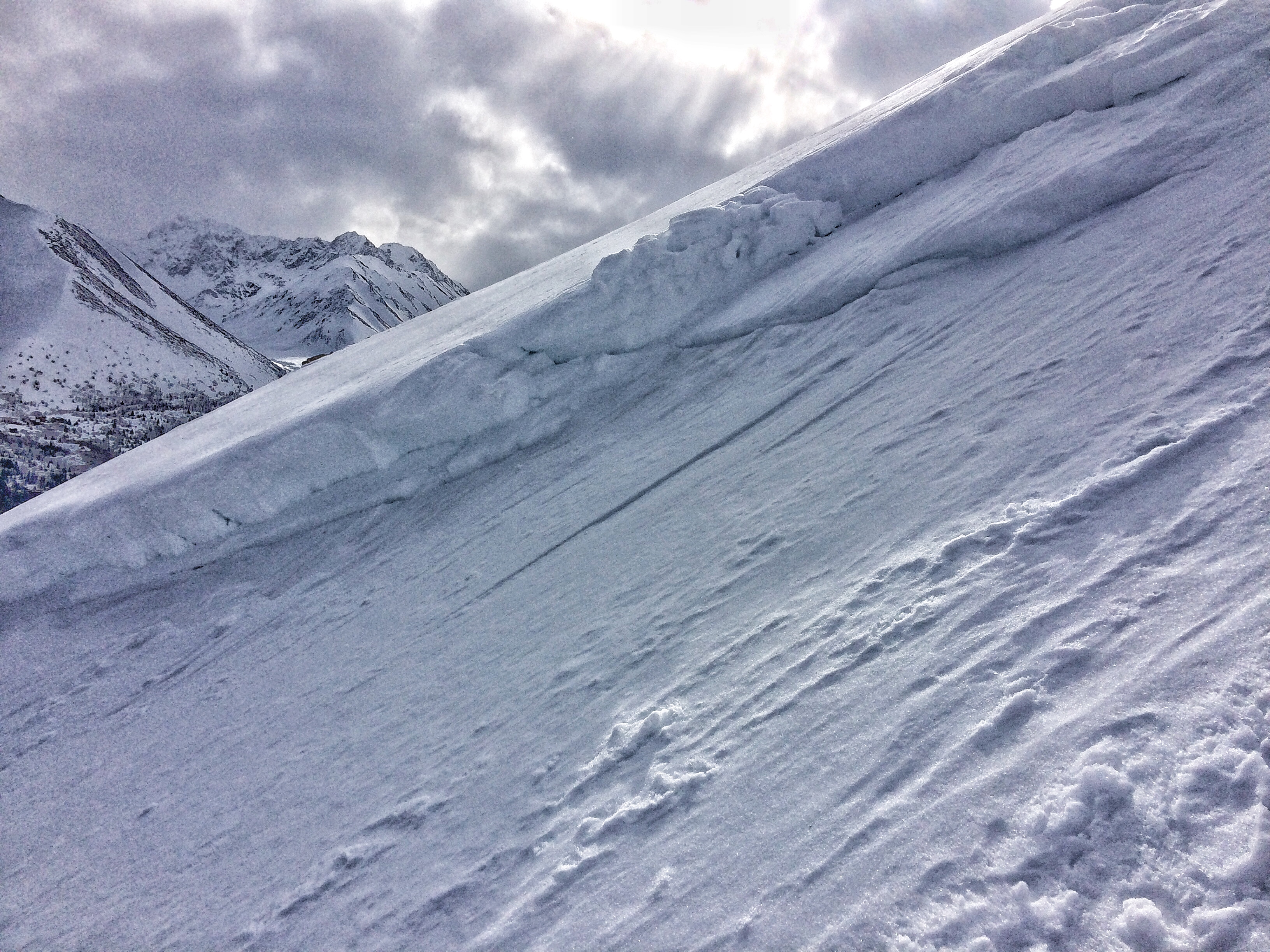
Debris views (measured up to 5′ deep):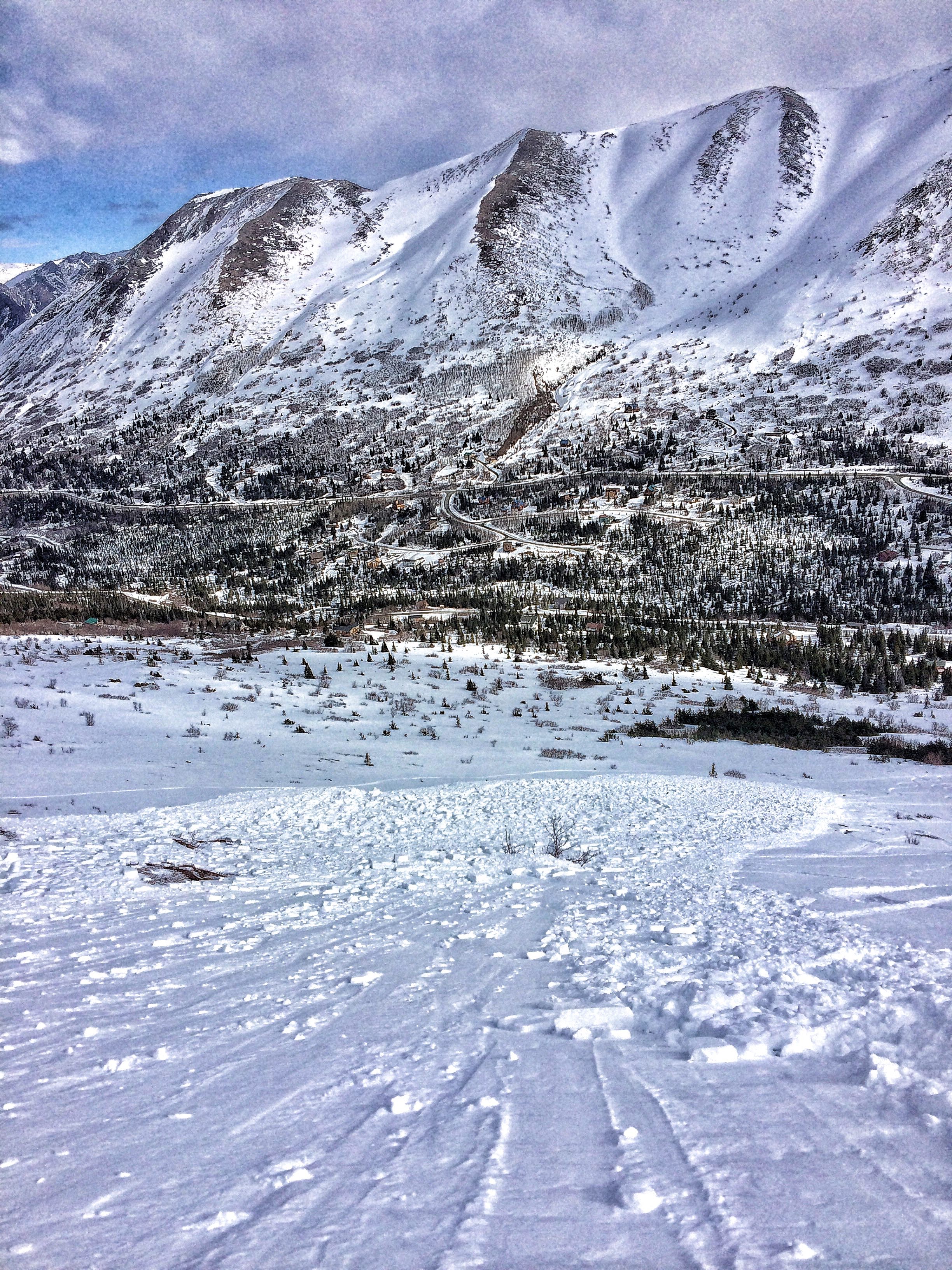
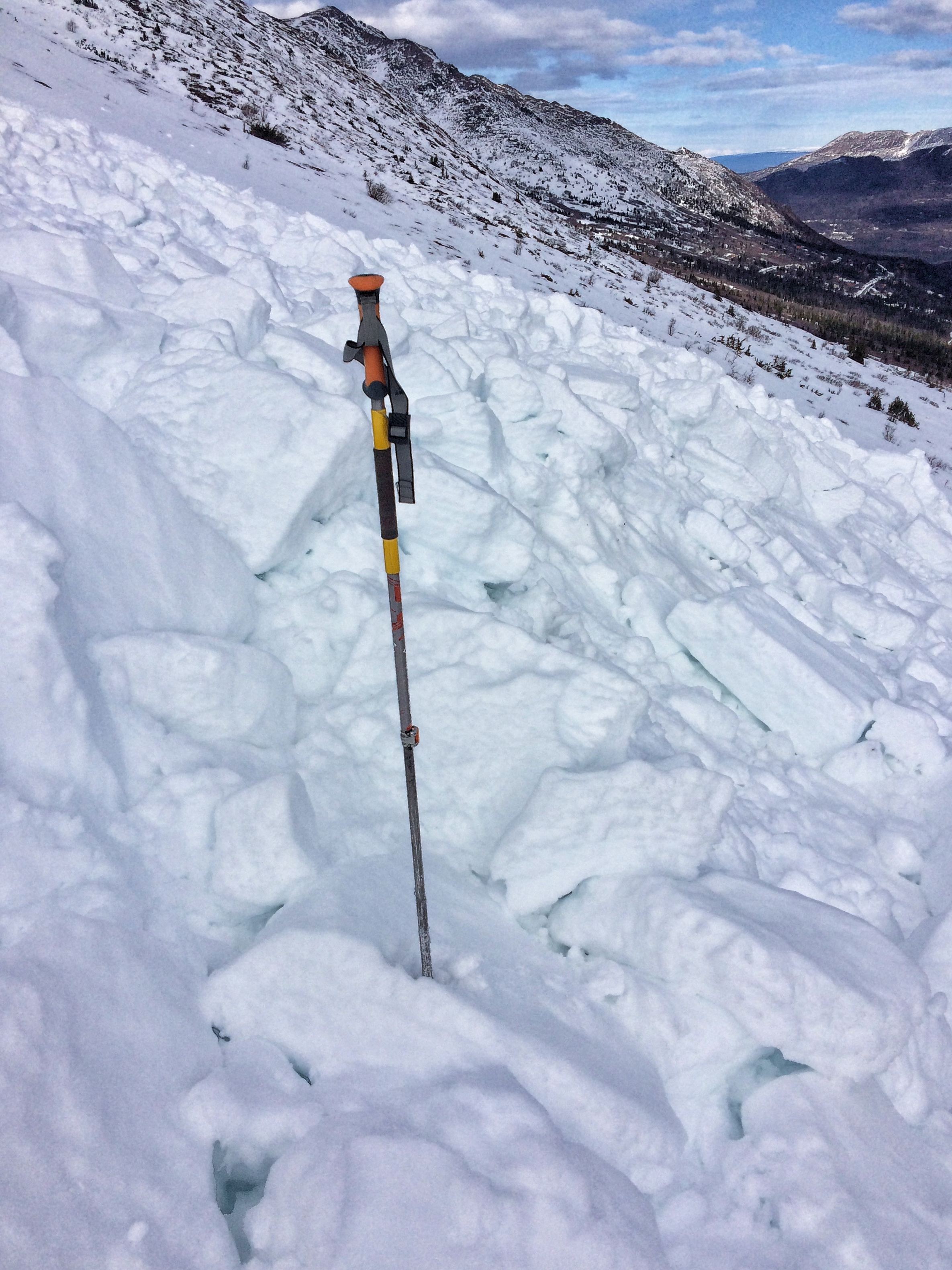
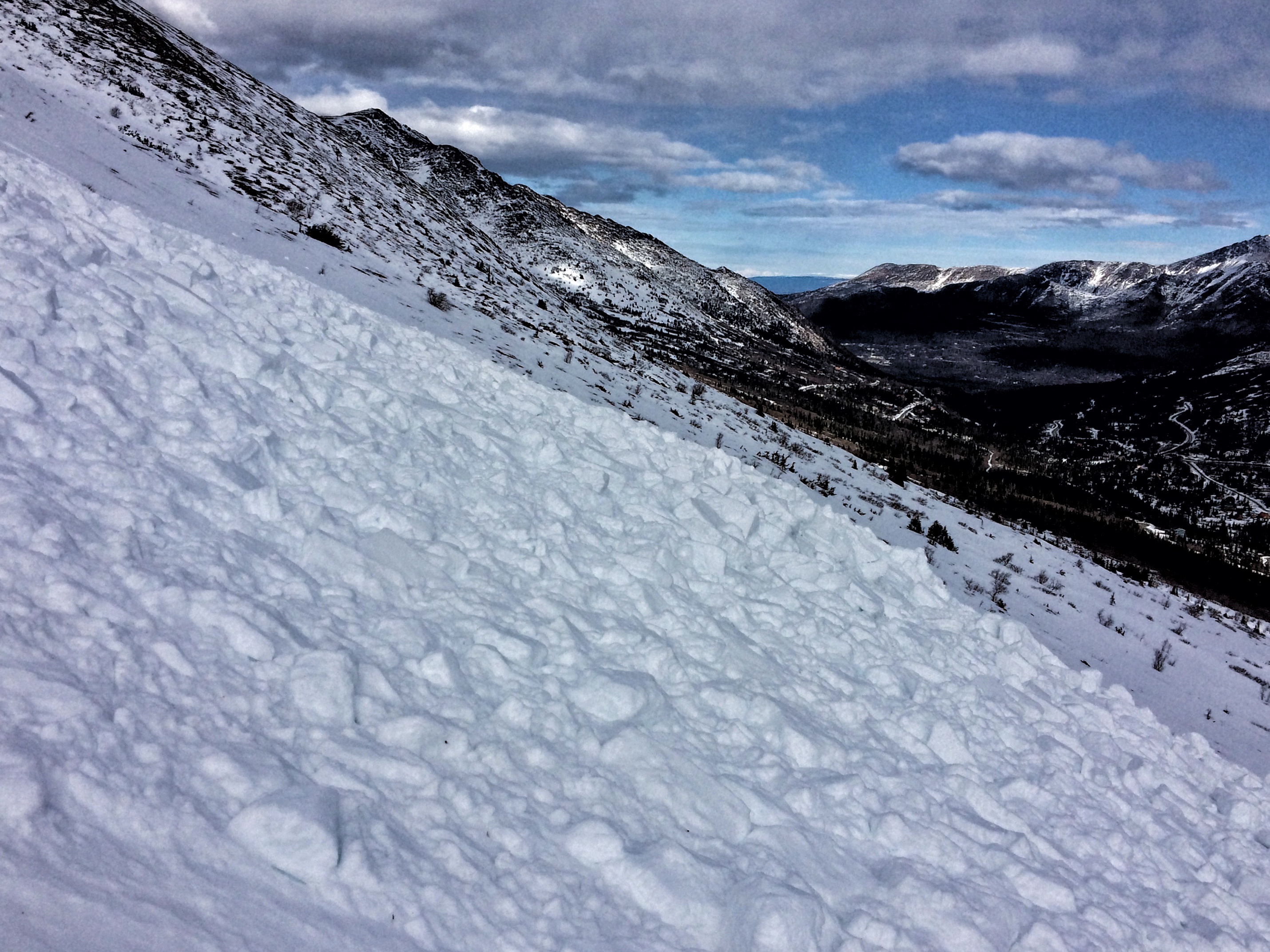
Other notes:
- Natural loose and slab avalanches in the 2 bowls area starting at ~4500′ and running 500+’ (likely triggered from cornice fall or initiated by wind loading) W aspect
- Natural wind slab avalanches from N aspect cross-loaded gully sidewalls below Rendezvous Peak
Front Range: Ptarmigan Peak
Harrowing and detailed account of a close-call in the S-Couloir on Tuesday (big thanks to the involved party for sharing):
I’ve skied the “S Couloir” (North Ptarmigan Peak) twice before. Once I climbed from Powerline Trail to the saddle directly fall-line to the couloir proper (eastern ridge of Ptarmigan Peak) and the second time I skied the “S” proper, ascending Ptarmigan from the southwest and traversing above the exposure into the couloir. Both of these times the snow conditions were marginal – variable in terms of quality snow for skiing and mostly hard snow.
Being on a north aspect in the Front Range (FR), on a terrain feature which seems to suck up and hold more snow than many of the other routes that are often skied in the FR, I’ve always felt this route to be a bit eerie. Hardpack and/or breakable crust with underlying facets has been my general experience. Yet I had always felt that if timed properly this route could be skied in perfect powder conditions (and I’m sure it has been) and thus had I it in my mind that I would one day attempt to ski it again under those such conditions.
During Saturday’s (3/19/16) snowfall I started thinking it might be the opportune time to make that happen. And if it were not for the combination of wind and rising temps which occurred beginning early on Sunday, it very likely would have been perfect conditions for powder skiing on all routes in the FR.
On Tuesday afternoon, fully aware of the complications created by the wind events and temperature shifts, we decided to go “have a look” anyways. On our first feel of a wind loaded north aspect (short traverse to Ptarmigan’s west ridge via Ptarmigan Pass) we immediately were aware of the upside down nature of the snowpack. With our ski poles we easily felt the hollowness and the harder faceted layer underlying the wind effected layer formed from the new snowfall. We decided to go one at a time on this short, but steep, traverse with the idea that it might be a test slope for conditions we might encounter further up on Ptarmigan’s north face. Neither of us experienced any cracking, settlement, or whoomphing and there did not seem to be any potentially propagating slab formation. It seemed like high quality wind packed powder. Based on this, we discussed the fact that there very well could be formidable wind slab formation on the summit ridge and decided to proceed with caution – not fully committed, but to go further and “have a look.”
When we crossed onto Ptarmigan’s southern aspect in route for the summit we immediately noted, and were impressed by, how deep the new snow was. We again proceeded one at a time across the traverse to the summit route (boot pack directly up the south face to the summit ridge). While certainly deep, due to a few days of warming, the south snow had thoroughly metamorphosed and bonded to the old snow. There was no evidence of slab formation here. We did have concerns that there might be wind slab facing south and/or west up towards the summit ridge and that we might be exposing ourselves by climbing, but we felt fairly safe, continued on and found nothing of concern.
From the summit the north slopes leading into the “S Couloir” route looked pristine. However, we were still not committed to skiing it. We elected to continue east down the ridge to the saddle entrance and “have a look”.
When thinking about this route I had previously identified several avalanche hazard locations. In reality this route is quite intricate. The stand-out hazards when attempting the traverse entrance from the Ptarmigan summit are 1.) the potentially wind loaded entrance, 2.) the entire ‘hanging snowfield’ traverse (both 1. and 2. above highly consequential large exposure), 3.) traversing further to underneath the first potentially loaded concave pocket which hangs above the main portion of the descent route, 4.) several other potentially loaded pockets which extend to north and east around the entire cirque which hangs above the skiers right portion of the route and below the next large exposure above the skiers left dog leg turn required to reach the lower couloir portion of the route, and 5.) the possibility that one could trigger a slab while crossing over the convex rollover halfway through the dog leg transition. Overall, the hazards are continuous throughout this route. Its intricacy is not to be underestimated.
In retrospect, based on all that, and according to the conditions at the time, deciding to ski this route was a pretty big gamble and probably would be a ‘no-go’ for most people, on this day particularly.
Heading down the ridgeline to the saddle we found another test slope, a fairly large wind pillow about 8 feet off the ridge into a directly north facing aspect. It was in a fairly safe location and I thought we might dig a snow evaluation pit here. Instead, my partner decided to attempt to get the pillow to fracture by jumping on it heavily with his skis. He hammered on it hard numerous times and even though the feature was thick and a bit hollow sounding he could not get it to collapse or translate into a slab. To us the result showed stronger than expected stability on a heavily wind loaded feature which we had expected to release. Not only did not the feature collapse, the ski penetration was a creamy and soft 10”. Not something one often encounters on wind pillows on high ridges in the FR.
With some confidence inspired, we nonetheless were not convinced and preceded cautiously to the saddle which forms the main entrance to the route. I was not really sure how to go about adequately assessing the snow here without exposing myself to the full consequences of the route. My partner began his attempt to evaluate the slope by cautiously ski cutting and jumping on the panel just below the ridge line. He crossed the slope 3 times doing this ski cutting maneuver and after no negative result stopped on the skier’s right flank of the entry pitch approximately 40 vertical ft. from the ridge. We discussed it and decided we were comfortable with what we had seen up to this point and elected to precede one-at-a-time to an ‘island safety’ underneath a large rock near the end of the eastwardly traverse from the summit ridge to the “S Couloir” fall-line zone. My partner did several slow and controlled jump turns on the entryway panel and then ski fluidly around the corner and underneath the rocks without incident, stopping at the identified meet-up point. He called me down.
At this point, while not entirely lacking skepticism, my confidence was up. Again, the conditions seemed to be high quality wind packed powder. I dropped in and stayed on my partner’s exact route. Approximately 5 turns down (perhaps 40-50 vertical feet) the panel collapsed. I immediately knew what was happening and I was well aware of the consequences of such an event based on the particular position I was in (several hundred feet of exposure in the fall-line directly below me). In an attempt to get out of the slide I immediately began trying to force myself skiers right. I fought as hard as I could but the avalanche would not let me go. It had me locked in its grasp and I thought for sure I was about to meet my end in the exact fashion of any “S Couloir” skier’s worst nightmare – a tumble over the massive exposure on the hanging traverse. I could see the edge of the rocks coming and was just about completely out of hope when all of a sudden my body caught a pocket of lower angled, less consolidated, snow and I came to stop approximately 10 vertical feet from the edge of the rock as all of the snow from the slab which released barreled around me and over the exposure. Bewildered, yet relieved, we both watched a massive debris cloud arise from the Powerline Trail basin below.
I believe that my fight to get myself skiers right helped me get to the position in which I ended up stopping at, otherwise I may have went directly fall-line and thus over the entire exposure – a fall which in all likelihood would not be survivable (see red arrow in photo).
Survival accomplished for the time being, our challenges and concerns were certainly not over. Both of us were now on-slope above large exposure with potential avalanche hazards and/or hangfire surrounding us. My partner said he would not proceed down the route any further and that he would cautiously climb his traverse route to the avalanche’s flank and then climb the bed surface back up to the ridge. He was probably in a more dangerous position than I was at this time being that he would need to re-cross the loaded slope above the exposure, but based on the potential for triggering another sizeable avalanche while descending further down the route, I agreed this was the best decision. I had the advantage at this point because, for the most part, the slope I would need to climb had already been cleaned out – almost my entire route would be on the bed surface. Nonetheless, after what had just occurred, I was really worried that my partner’s weight might be just enough to trigger another slab somewhere on his traverse. We discussed it and he said climbing up was his firm decision. We agreed that I should climb out first and then once I had obtained the ridge he would be begin his ascent.
With the need to switch over to climbing mode, I very carefully used my ice axe to chop out a secure platform at my stopping position. Luckily I had crampons in my pack, as getting these on my feet provided a needed sense of security after almost falling over the exposure. All I really wanted to do at this point was safely make the climb to the ridge. But of course, having the ‘luxury’ of being able to climb the bed surface and investigate the crown of the avalanche which nearly swept me to my death, I made an attempt to assess the snow conditions which led to this event, to the best of my ability in the state of mind I was in.
I had come to a stop in a pocket of loose facets which was also filled in by loose storm snow from underneath the upside down windslab. A harder bed surface in combination with a hard slab and I very likely would not have stopped, even in the lower angle pocket. As I climbed, the conditions changed from loose facets on rocks to typical FR breakable wind crust which broke and gave way to underlying facets with each step. A few hundred feet up (perhaps 150 vertical feet down from the ridgeline and 45 degrees slope angle – a guess) I gained the actual bed surface which was perhaps fist hard older wind slab covered in a small layer surface facets (what was left of the facets anyways). Step kicking in the bed surface was secure and I got full toe penetration with my boots and no collapsing to any underlying facets. It was a clean-slate, a text-book interface for release of a thick upside down wind slab. As I approached the crown the pitch got steeper and all I could think about was the possibility of triggering hangfire and being swept down the slope again. The deepest part of the crown (off to the climber’s right) was approximately 18” and from that deepest point the crown tapered down to 4” or 5” at its flanks furthest down. I did not spend time doing any detailed investigation of the interface between the slab and the crown. I hesitantly stepped over the crown and onto the remaining slab and successfully attained the ridge about 20 steps later.
Relieved and on the ridge, I got eyes-on my partner and called him up. He carefully navigated his way without incident. We returned to the summit of Ptarmigan Peak and safely descended the south face to the Rabbit Creek TH.
I won’t go on here into any big philosophizing about the psychology of our decision making process. We are not making any excuses. Lots of red-light signs were there. Although, the conditions were certainly tricky to figure out (both of us have been bc skiing for over twenty years and like to think we know what we are doing most of the time) we knew there was good reason to be suspect. While we walked with caution but we also WANTED to think it was relatively safe, that any of the hazards were manageable (i.e. “let’s just go have a look”). One thing I wondered about a whole bunch on the ridge after climbing back out was how many times in the past I had made similar decisions and was probably just lucky enough to squeeze by unscathed. Another thing I will mention is that many of us have become lazy or in a rush and have begun to rely too heavily on ski pole tests and just overall feeling for our decision making and are not taking the time to do scientifically administered snow pit tests in the field nearly as much as we should be. I have become extremely guilty of that over the last several years. Doing that somehow/somewhere this time around probably would have made a difference in our decision. There is a lot more to talk about and I am open to talking about it with anyone.
Lastly, fair warning to ANC skiers who don’t already know – “S Couloir” is a tricky and potentially dangerous route, with consistently faceted snowpack and multiple hazards, and should not be taken lightly.

